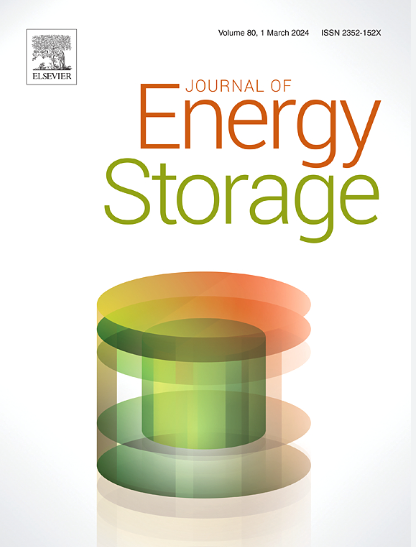采用原位聚合法制备了PVDF-HFP/YSZ纳米纤维复合固态电解质,用于4.5 V高压NCM811电池
IF 8.9
2区 工程技术
Q1 ENERGY & FUELS
引用次数: 0
摘要
采用固体聚合物电解质的固体锂金属电池具有能量密度高、安全性好等优点。然而,它们的应用仍然受到不稳定的固体电解质界面(SEI和CEI)和不受控制的枝晶生长的阻碍。本文设计了在PVDF-HFP纳米纤维长丝表面加载介质填料钇稳定氧化锆纳米粒子(YSZ)的复合骨架,并在该骨架上原位聚合DOL(1,3-二氧唑烷)制备了新型复合固体电解质(CSE),实现了安全稳定的高压锂金属电池(LMB)。原位构建的双稳定电极界面(CEI和SEI)可以有效抑制锂枝晶的生成,抑制高压NCM811正极结构的退化和NCM811颗粒裂纹的产生,赋予电池非凡的性能。在30℃条件下,CSE的离子电导率为1.01 × 10−3 S cm−1,电化学窗口扩大为6.0 V, Li+转移数为0.72。所制备的Li|NCM811电池在4.5 V截止电压和1C电流密度下可稳定循环400次,每循环容量衰减仅为0.074%。本文章由计算机程序翻译,如有差异,请以英文原文为准。
A PVDF-HFP/YSZ nanofiber composite solid-state electrolyte by in-situ polymerization of 1,3-dioxolane for 4.5 V high-voltage NCM811 battery
Solid lithium metal batteries with solid polymer electrolytes have advantages in terms of high energy density and safety. However, their application is still hindered by unstable solid electrolyte interfaces (SEI and CEI) and uncontrolled dendrite growth. Here, a composite skeleton loaded with dielectric filler yttrium stabilized zirconia nanoparticles (YSZ) on the surface of PVDF-HFP nanofiber filaments is designed, and a novel composite solid electrolyte (CSE) is prepared by in-situ polymerization of DOL (1,3-dioxolane) on this framework to achieve safe and stable high-voltage lithium metal battery (LMB). The dual stable electrode interfaces (CEI and SEI) constructed by in-situ can effectively suppress the generation of lithium dendrites and suppress the degradation of the high-voltage NCM811 positive electrode structure and the generation of cracks in NCM811 particles, endowing the battery with extraordinary performance. The as-obtained CSE exhibits high ionic conductivity of 1.01 × 10−3 S cm−1 at 30 °C, the enlarged electrochemical window of 6.0 V, and the Li+ transference number is 0.72. The assembled Li|NCM811 battery is capable of stable cycling for 400 cycles at a cut-off voltage of 4.5 V and current density of 1C, with a capacity decay of only 0.074 % per cycle. .
求助全文
通过发布文献求助,成功后即可免费获取论文全文。
去求助
来源期刊

Journal of energy storage
Energy-Renewable Energy, Sustainability and the Environment
CiteScore
11.80
自引率
24.50%
发文量
2262
审稿时长
69 days
期刊介绍:
Journal of energy storage focusses on all aspects of energy storage, in particular systems integration, electric grid integration, modelling and analysis, novel energy storage technologies, sizing and management strategies, business models for operation of storage systems and energy storage developments worldwide.
 求助内容:
求助内容: 应助结果提醒方式:
应助结果提醒方式:


